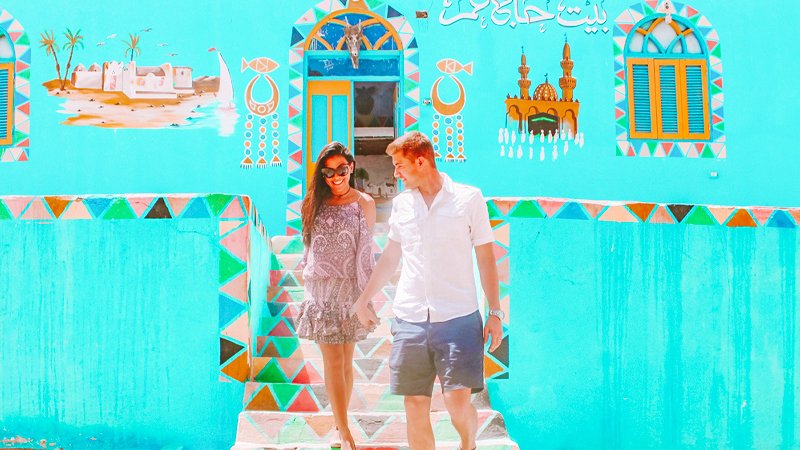Egypt’s allure extends beyond its iconic pyramids and bustling cities. Along the serene banks of the Nile River, a vibrant tapestry of culture and tradition thrives in the heart of Nubia. These enchanting villages, home to the Nubian people, offer a glimpse into a way of life that has remained remarkably preserved for centuries. Embark on a journey to these captivating oases, where colorful houses, warm hospitality, and ancient traditions await.
A Timeless Legacy: The Nubian People and Their Heritage
The Nubians, an indigenous ethnic group with a history that predates the pharaohs, have inhabited the Nile Valley for millennia. Their rich cultural heritage, a blend of African, Egyptian, and Arab influences, is reflected in their unique language, customs, and way of life. Despite facing displacement due to the construction of the Aswan High Dam, the Nubians have persevered, maintaining their traditions and welcoming visitors to their vibrant communities.
A Kaleidoscope of Colors: Nubian Architecture and Design
Nubian villages are a feast for the eyes, with their brightly painted houses adorned with intricate geometric patterns and symbolic motifs. Each house is a work of art, reflecting the creativity and craftsmanship of the Nubian people. The use of vibrant colors, such as turquoise, yellow, and orange, creates a cheerful and inviting atmosphere that perfectly complements the serene natural surroundings. The houses are typically built from mud bricks and topped with domed roofs, a design that provides natural insulation and helps to keep the interiors cool in the scorching desert heat.
Warm Hospitality: The Nubian Way of Life
Nubians are renowned for their warmth, hospitality, and welcoming spirit. Visitors to their villages are greeted with open arms and treated to a taste of traditional Nubian life. You’ll have the opportunity to interact with local families, learn about their customs and traditions, and savor delicious Nubian cuisine. You can also participate in cultural activities, such as henna painting, music performances, and traditional dances. The Nubians’ genuine warmth and hospitality create an unforgettable experience for travelers.
Culinary Delights: Savoring Nubian Cuisine
Nubian cuisine is a flavorful fusion of African, Egyptian, and Arab culinary traditions. Dishes are typically prepared with fresh, locally sourced ingredients and are known for their bold flavors and unique combinations. Some of the must-try Nubian dishes include tagine, a slow-cooked stew made with meat, vegetables, and spices; fatta, a layered dish of bread, rice, meat, and tomato sauce; and molokhia, a soup made with jute leaves, garlic, and coriander. Nubian cuisine is a culinary adventure, a feast for the senses that reflects the region’s diverse cultural heritage.
Rhythms of the Nile: Music and Dance in Nubian Culture
Music and dance are integral to Nubian culture, serving as a form of expression, celebration, and social bonding. Traditional Nubian music is characterized by its rhythmic beats, melodic vocals, and the use of indigenous instruments, such as the tambourine, the oud, and the rababa. Nubian dances are lively and energetic, often involving intricate footwork and expressive movements. Visitors to Nubian villages can witness these vibrant performances, which offer a glimpse into the heart and soul of Nubian culture.
A Journey to the Past: Exploring Nubian History and Traditions
Nubian villages offer a unique opportunity to delve into the region’s rich history and traditions. Visit the Nubian Museum in Aswan, which houses a collection of artifacts and exhibits showcasing Nubian culture, history, and art. Explore the ancient ruins of the Nubian capital of Kerma, which dates back to the 25th century BC. Discover the traditional crafts of the Nubian people, such as pottery, weaving, and basketry. A journey to a Nubian village is a journey through time, a chance to connect with the past and appreciate the enduring legacy of this remarkable civilization.
Practical Tips for Visiting Nubian Villages
Location: Nubian villages are located along the Nile River, primarily in the Aswan region.
Getting there: Most visitors reach Nubian villages by taking a boat trip from Aswan. Boat trips are readily available and offer a scenic journey along the Nile.
Best time to visit: The best time to visit is during the cooler months, from October to April, to avoid the scorching summer heat.
What to wear: Dress modestly, especially when visiting local homes. Bring a hat, sunglasses, and sunscreen to protect yourself from the sun.
Respect local customs: Be respectful of Nubian culture and traditions. Ask for permission before taking photos of people or their homes.
Support local businesses: Purchase handicrafts and souvenirs from local artisans to contribute to the local economy.
Conclusion: Nubian Villages – A Cultural Oasis
Nubian villages, a vibrant tapestry of color, tradition, and warm hospitality, offer a unique and enriching experience for travelers. A visit to these enchanting communities is a chance to step off the beaten path, connect with the local people, and immerse yourself in a culture that has remained remarkably preserved for centuries. Let the rhythm of the Nile and the vibrant spirit of the Nubian people guide you on a journey of discovery that will leave a lasting impression.

